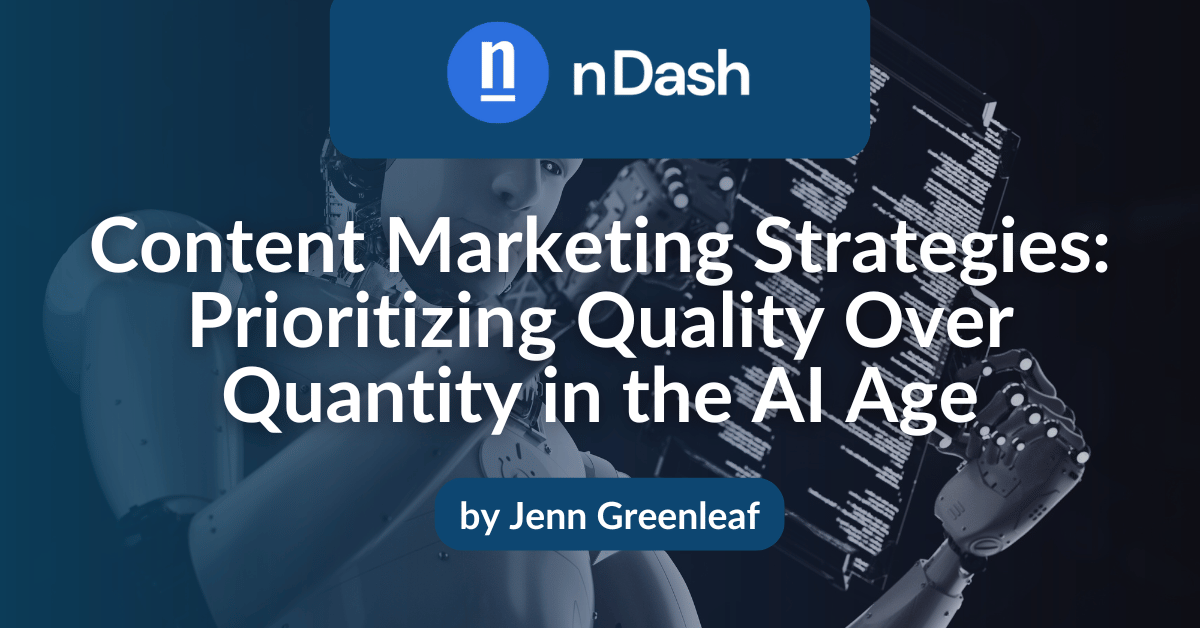The rise of AI is shaking up content marketing, forcing a rethink of traditional strategies. This blog looks at the key trends AI is driving, exploring its impact on SEO, content quality, and audience engagement. We’ll also analyze how to leverage AI to enhance content marketing strategies.
While AI brings its own set of advantages, the essence of content creation that truly resonates with audiences lies in the human touch. It’s the human skill in crafting high-quality and genuine content that remains irreplaceable.
Prioritizing Quality Over Quantity in Content Marketing
As digital consumers become more selective, the demand for informative, engaging, and trustworthy content is skyrocketing. This shift is forcing content marketers to move away from a quantity-based approach and focus on crafting valuable content that fosters brand loyalty and drives business success.
Focus on Quality Over
Advancements in AI technology significantly influence this trend. Here are some key statistics and trends highlighting the shift towards quality:
- 80% of marketers believe AI will positively impact their SEO efforts.
- 80% of marketers agree that generative AI can improve the quality of their content.
- 62% of marketers believe AI will boost content quality in the long run.
Benefits of prioritizing quality in content marketing:
- Enhances trust and brand loyalty
- Leads to better business performance
- Fosters a genuine connection with the audience
AI’s role in enhancing quality in content marketing:
- AI tools assist in generating ideas, enhancing language, and automating routine tasks
- The emergence of “human-AI content teams” where humans and AI work together in content marketing
Despite AI’s capabilities, human-written copy often outshines AI-generated content due to its ability to incorporate nuances and emotional resonance in content marketing.
👉 Click here for more information: Marketing Strategies and Content Creation: Generative AI’s Role – nDash.com
Techniques to Ensure Consistent Quality
Struggling to maintain consistent quality in your content? These techniques will help you create impressive pieces every time.
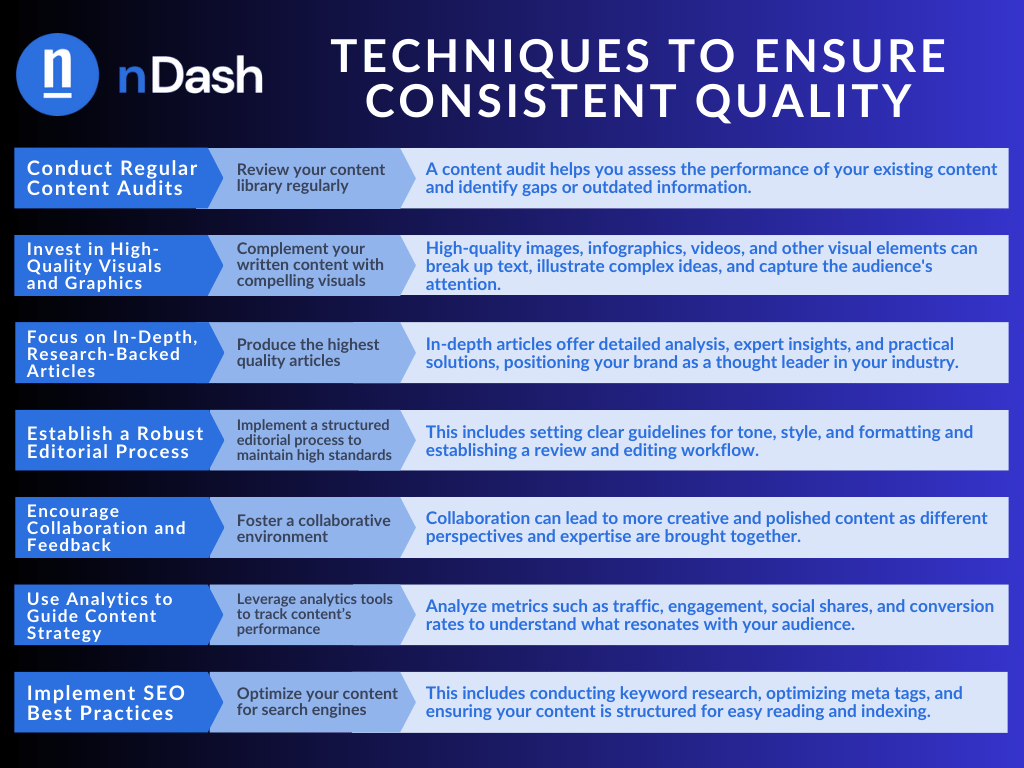
Cara McCarron, President of The Content Company, summarizes this shift: “People aren’t okay with fluff pieces and filler anymore. Quality is the name of the game.”
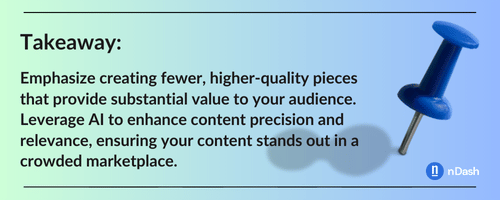
💡 Action items:
- Train your team on visual content creation: Equip your team with skills to create high-quality visuals and graphics.
- Develop a research strategy: Create a plan for conducting and incorporating thorough research into your content to ensure depth and accuracy.
Embracing Humanized Brand Voices in Content Marketing Materials
AI speeds up content creation, but it can’t replace the human connection. Today’s consumers seek genuine connections with brands that truly “get” them. Infusing a brand’s voice with personality and values can build trust and loyalty. That goes beyond consistency—speak in a way that reflects their unique personality and commitment to their customers.
How AI Can Lead to a Robotic Tone in Content Marketing
While AI technology offers unparalleled consistency in content creation, it can inadvertently lead to a robotic tone that lacks warmth and authenticity. Automated content, though efficient, often misses the nuances and emotional resonance that human writers naturally incorporate.
As a result, there’s a growing shift towards more authentic, human-like brand communications. Brands are recognizing that their voice needs to reflect genuine understanding and empathy to build trust and foster stronger connections with their audience.
The Drawbacks of a Robotic Tone in Content Marketing Materials
Despite these advantages, the primary drawback of AI-generated content is its tendency to sound robotic. AI often struggles to replicate the subtleties of human communication, such as humor, sarcasm, cultural references, and emotional depth.
This lack of human touch can make the content feel cold and detached, which may not resonate well with audiences seeking authentic and relatable brand interactions. The absence of personal voice and character in AI content can hinder the development of a genuine connection with the audience, affecting brand loyalty and engagement.
The Importance of Authenticity and Emotional Resonance
In contrast, human writers naturally infuse content with personality, empathy, and creativity. They can tailor messages to reflect the brand’s unique voice and adapt the tone to suit different contexts and audiences.
Human writers are adept at crafting stories that evoke emotions, inspire action, and build meaningful connections. This emotional resonance is crucial for creating content that not only informs but also engages and entertains the audience.
The Shift Towards More Authentic, Human-Like Brand Communications
Brands are moving away from sterile, one-size-fits-all messaging and instead adopting more conversational and engaging tones. This approach is not only more relatable but also more effective in engaging audiences.
Over 60% of B2B businesses include link-building in their content marketing strategy, pointing to the importance of creating content that builds credibility. High-quality, engaging content not only attracts backlinks but also enhances the brand’s authority and trustworthiness.
Focusing on producing valuable, informative content that addresses the specific challenges and interests of their audience, content marketing managers can position themselves as thought leaders in their industry. High-quality content pulls in organic traffic and is linked to other respected sites, boosting its visibility and impact.
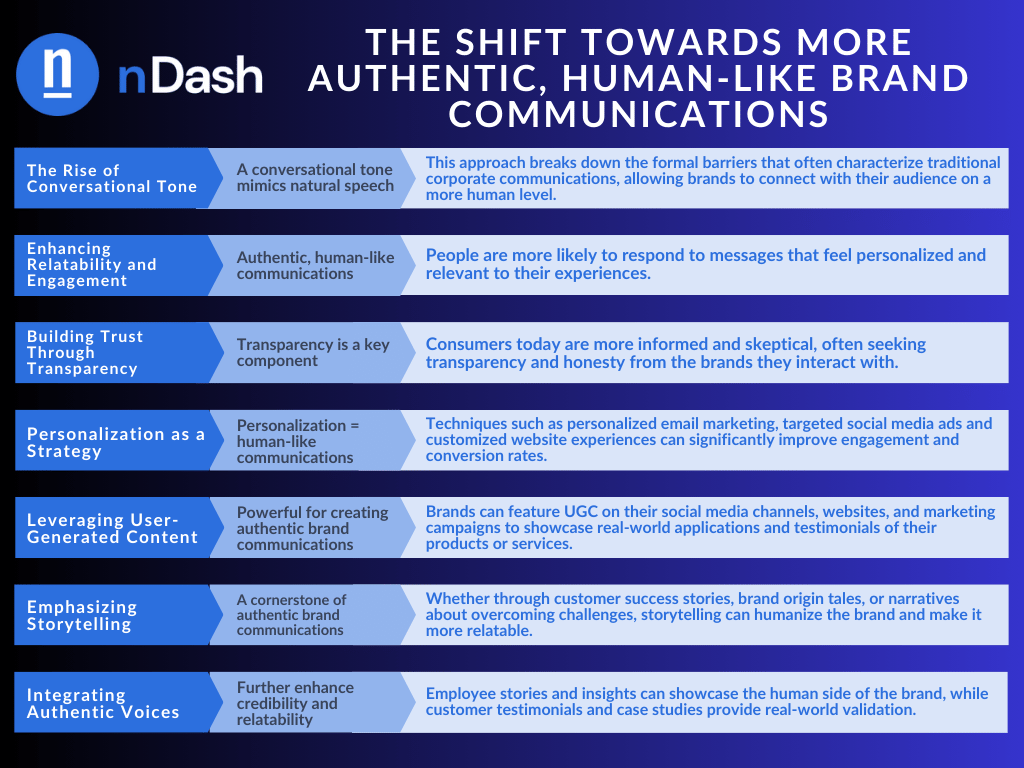
👉 Click here to read more about brand authenticity: Innovation vs. Integrity: The Impact of AI on Brand Authenticity and Consumer Trust – nDash.com
Practical Tips for Brands to Adopt a Conversational and Engaging Tone
Moving away from sterile, corporate language can significantly enhance engagement. Embracing a more human, relatable voice helps build stronger relationships with your audience.
Here are some practical tips to help your brand achieve this transformation:
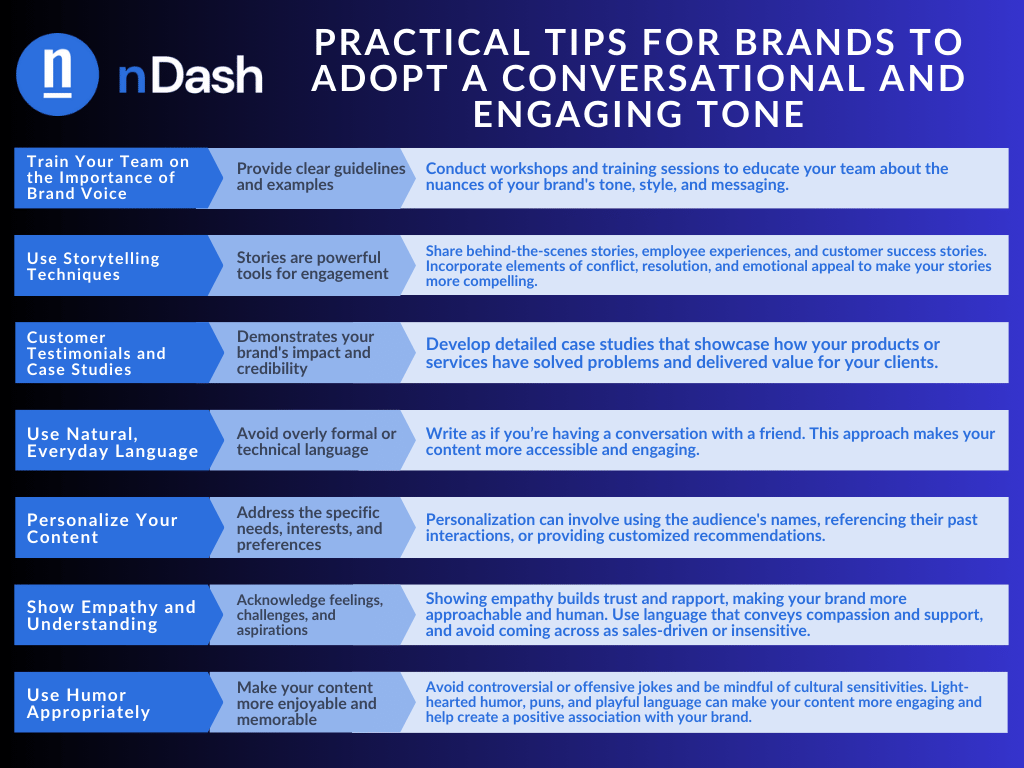
“In my career, I’ve learned that creating high-quality, ghostwritten content, particularly in niche industries, hinges on building trust and internal relationships with those you represent. It’s about ensuring that their representation in the market is accurate and favorable,” explains Jessie Coan, Director of Marketing at CyberMaxx.
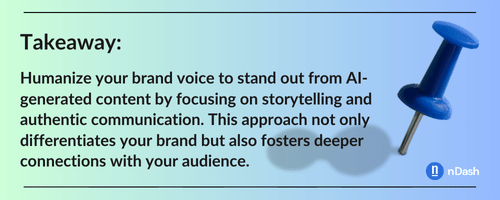
💡 Action items:
- Engage on social media: Actively participate in conversations with your audience on social media platforms. Respond to comments, ask questions, and share user-generated content to foster a sense of community. Show that your brand values customer interactions.
- Create a brand voice style guide: Develop a comprehensive style guide that outlines your brand’s voice, tone, and personality. Include specific examples of desired language, phrases, and communication styles. Distribute this guide to all team members involved in content creation to ensure consistency.
- Leverage AI tools with human oversight: Use AI tools to streamline content creation but ensure there is a human review process in place. Have skilled writers and editors refine AI-generated content to add the necessary emotional and empathetic touch, ensuring it aligns with your brand’s authentic voice.
Redefining Style Guides for the AI Era
Now more than ever, brands are swapping out rigid style guides for adaptable ones. This shift caters to audiences hungry for realness over manufactured perfection. These new guides celebrate a variety of voices and tones, empowering brands to forge genuine connections through personalized interactions rather than just churning out polished pronouncements.
Traditional Style Guides vs. Evolving Style Approaches
Traditional style guides have long served as the backbone for consistent and polished content across various platforms. These guides focus on maintaining a uniform tone, structure, and language usage, ensuring that all content produced by a brand adheres to established standards.
This consistency helps build a recognizable brand voice and maintain professionalism. Traditional style guides often include detailed rules on grammar, punctuation, formatting, and terminology, which are crucial for producing clear and cohesive content.
Modern style approaches recognize the dynamic nature of content creation and the diverse platforms where content is consumed. These evolving guides prioritize a balance between polished professionalism and a human touch, ensuring that content remains relatable and engaging without succumbing to the robotic overtones that AI-generated content can sometimes exhibit.
Embracing Flexibility and Adaptability
Evolving style guides allow for varying tones and styles depending on the context and audience. While maintaining a formal tone in official communications is important, a more casual and conversational tone might be appropriate for social media interactions. This flexibility ensures that content can adapt to different platforms and audience expectations, enhancing engagement and relevance.
Integrating AI Insights Responsibly
Modern style guides also integrate AI insights to optimize content creation. AI tools can analyze audience preferences, engagement patterns, and trending topics, providing data-driven recommendations for tone, style, and content structure.
Weaving these insights in, brands can craft laser-focused content that hits the mark. The secret sauce? Don’t lose sight of the human connection. Steer clear of overly technical or impersonal writing.
Encouraging Creativity and Innovation
Evolving style guides encourage creativity and innovation among content creators. By providing guidelines that support experimentation with different formats and styles, brands can produce unique and compelling content.
This approach prioritizes fresh and engaging content, keeping brands at the forefront. Encouraging creative freedom within the framework of core brand principles ensures that content remains authentic and aligned with brand values.
Maintaining Consistency with Flexibility
Modern style approaches offer flexibility while still emphasizing the importance of maintaining a consistent voice. This balance is struck by setting clear overarching principles that ensure a consistent brand voice while allowing for contextual adjustments.
A brand might establish a core tone that is always friendly and approachable. This way, the level of formality can then vary based on the platform and audience. This approach ensures that the brand’s identity remains intact while adapting to different communication needs.
Enhancing Relatability and Engagement
The primary goal of evolving style guides is to enhance relatability and engagement. By allowing for a more conversational and humanized tone, brands can connect with their audience on a deeper level.
Consumers’ growing desire for authenticity and personal connection makes this approach especially crucial. Evolving style guides help brands create content that feels genuine and approachable, fostering stronger relationships with their audience.
Balancing Polish with the Human Touch to Avoid AI Overtones in Content Marketing Materials
Marketers are cranking out content at an unprecedented rate – 75% credit generative AI for this surge. But while AI excels at mass content production, it struggles to capture the human element that truly resonates with audiences.
That’s where the irreplaceable human touch comes in. By infusing content with human insight, empathy, and creative spark, we can prevent it from feeling sterile and generic.
Cara McCarron underscores the importance of client buy-in. She states, “As long as the client buys into the strategy, there’s no problem.” This highlights the need for adaptable strategies that align with both brand values and audience expectations.
👉 Click here about how to spot AI-generated content: Identifying AI in Content Creation: Can We Spot the Difference? – nDash.com
Examples of Content Marketing Featuring Flexible, Adaptive Style Guides
Innovative brands are leading the way with flexible, adaptive style guides that cater to the dynamic nature of modern content creation. These guides often include provisions for varying tones and formats, encouraging writers to experiment while staying true to core brand principles.
For instance, a style guide might allow for more casual language in social media posts while maintaining a formal tone for official communications. This adaptability ensures that content remains fresh and engaging across different contexts and platforms.
Let’s explore some specific examples of how leading brands are implementing these innovative style guides:
Slack’s Content Marketing Style
Slack, a leading collaboration tool, has developed a highly adaptive style guide that reflects its playful and approachable brand voice. Their guide includes detailed instructions on how to adjust the tone for different content types.
For instance, Slack encourages a friendly and informal tone for blog posts and social media interactions while maintaining a more straightforward and professional tone for technical documentation and customer support. This flexibility allows Slack to connect with diverse audiences while preserving a cohesive brand identity.
Mailchimp Adaptability
Mailchimp’s content style guide is another excellent example of adaptability. Known for its quirky and friendly brand personality, Mailchimp allows its writers to inject humor and casual language into marketing emails and social media content.
However, the guide also emphasizes the importance of clarity and professionalism in other communications, such as product updates and legal notices. This dual approach ensures that Mailchimp’s content is both engaging and trustworthy.
Airbnb’s Diverse Content Marketing Plan
Airbnb bridges cultures through content. Their global style guide ensures a warm, welcoming tone for hosts, fostering connections. Guests, on the other hand, receive informative, reassuring content, building trust. This adaptability creates personalized, culturally relevant experiences for users worldwide.
For instance, greetings might be tailored to reflect regional customs. In some cultures, a casual “Hi” is appropriate, while others might prefer a more formal salutation. This adaptability ensures all users feel welcome and respected, regardless of location.
Spotify’s Creative Content Marketing Efforts
Spotify’s style guide embraces flexibility to match the vibrant and diverse nature of its brand. It allows for creative freedom in marketing campaigns, social media posts, and playlist descriptions, encouraging a lively and energetic tone.
At the same time, Spotify maintains a clear and professional style for user guides and terms of service. This balanced approach helps Spotify appeal to its youthful and diverse audience while maintaining credibility and trust.
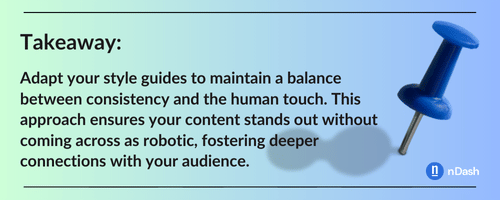
💡 Action items:
- Update your style guide: Incorporate guidelines that allow for a more flexible and conversational tone, adapting to different content needs and audience preferences.
- Encourage experimentation: Motivate your writers to try different styles and formats, fostering their creativity and innovation in content creation.
- Regular reviews and revisions: Continuously review and revise your style guide to keep it relevant and aligned with evolving brand and audience dynamics.
The Renaissance of Creative Content
Information overload is a content creator’s worst enemy. To rise above the noise, brands need fresh ideas and killer storytelling. Originality, not just “different for differing’s sake,” is key in content marketing.
Unique perspectives, engaging narratives, and high-quality production grab attention and create lasting impressions. This creative focus isn’t just about standing out; it’s about delivering real value and experiences that make your brand unforgettable.
Content Saturation and the Need for Differentiation
Today, brands struggle to be seen in the face of a content avalanche. That makes it increasingly difficult for any single piece of content to capture attention. Just churning out posts isn’t enough. To rise above the noise, content marketing managers need to embrace creativity and deliver fresh, valuable content that truly connects with their audience.
The sheer volume of content available means that audiences are more selective about what they consume. They gravitate towards content that not only provides value but also stands out in terms of originality and relevance. Brands failing to differentiate themselves risk being overlooked, regardless of the frequency or volume of their content production.
One key strategy for differentiation is understanding and addressing your audience’s specific needs and interests. Content that touches on a personal level is more likely to engage and retain attention. This requires brands to go beyond generic topics and explore niche areas that are directly relevant to their audience.
Creativity plays a crucial role in cutting through the clutter. Innovative formats, compelling visuals, and engaging storytelling can transform ordinary content into memorable and shareable content.
Brands can experiment with new approaches to capture their audience’s imagination and encourage deeper engagement. These approaches include interactive content, video series, podcasts, and immersive experiences.
Data and analytics are another weapon in the differentiation arsenal. By harnessing customer data, brands can unlock a deeper understanding of their audience’s desires. This intelligence empowers them to refine their content marketing strategies, ensuring maximum relevance. Personalization, fueled by data insights, takes this a step further, allowing brands to tailor content experiences to individual preferences and behaviors, fostering deeper engagement and solidifying their competitive edge.
Strategies for Brands to Foster Creativity and Craft High-Value Content
To effectively stand out, brands need to embrace strategies that foster creativity and enhance content quality. William Craig from Forbes emphasizes the importance of relevance and specificity.
He explains, “Textbooks on marketing tell you to aim for your target audience, but quality engagement is more than statistics and demographics. Never write or shoot for a generalized audience. Instead, be relevant, current, and specific.”
Here are some strategies to consider:
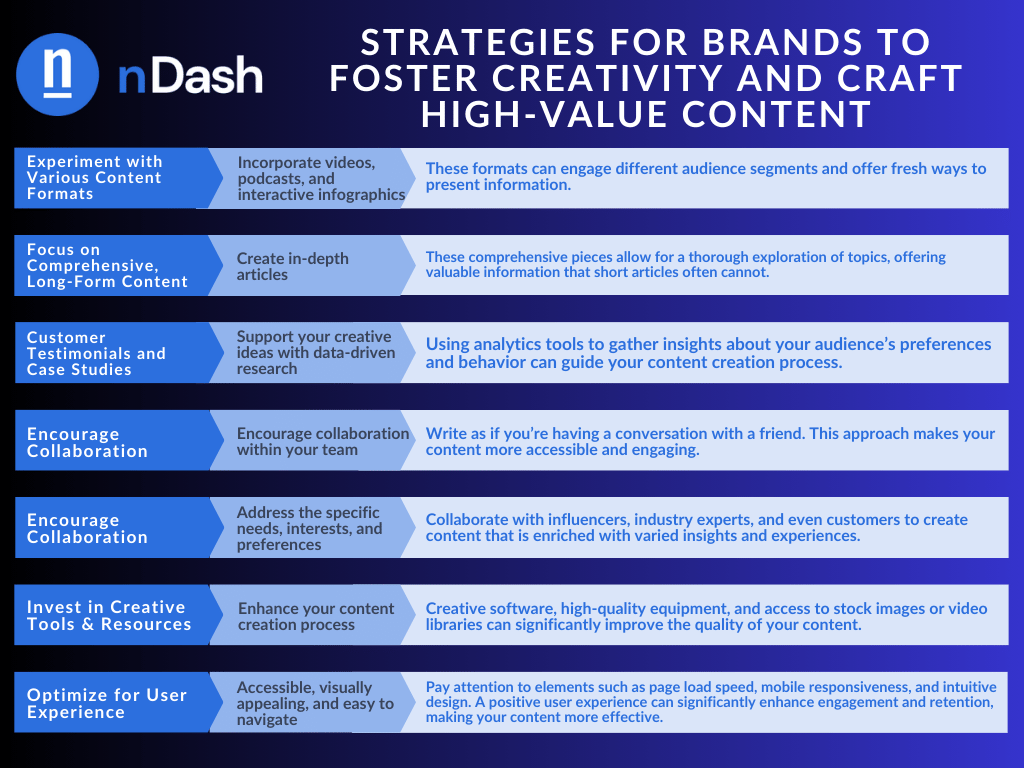
Trends in Leveraging Unique Content Formats
To cut through the noise, content marketing managers are increasingly exploring unique content formats. For example, 94% of B2B marketers create short articles and blog posts. There’s a growing trend toward leveraging long-form articles, interactive media, and other innovative formats. These formats not only capture attention but also provide more value and engagement opportunities for audiences.
Long-Form Articles
Long-form articles are gaining popularity as they allow for a more in-depth exploration of topics. These comprehensive pieces provide detailed analysis, case studies, and expert insights that short articles often cannot.
Long-form content positions brands as thought leaders and authoritative sources in their industries. It also caters to audiences seeking substantive, well-researched information, thereby enhancing credibility and trust.
Interactive Media
Interactive media is another powerful trend that is reshaping how we create content. Formats such as quizzes, infographics, and videos can transform passive consumption into active participation, fostering a deeper connection with the content.
- Interactive quizzes: Engage users by prompting them to answer questions and receive personalized results, making the content experience more memorable and enjoyable.
- Infographics: Combine visual appeal with concise information, making complex data more accessible and easier to understand.
- Videos (especially live streaming and webinars): Provide dynamic and engaging ways to present content, allowing for real-time interaction and feedback from the audience.
Podcasts
Podcasts are also becoming a popular content format. They offer a convenient and engaging way for audiences to consume content on the go. The intimacy of audio content allows brands to build a personal connection with their listeners.
This media can cover a wide range of topics, from industry trends and expert interviews to storytelling and educational series, providing valuable insights and entertainment. Their flexibility in terms of length and frequency also makes them a versatile addition to a brand’s content strategy.
Augmented Reality (AR) and Virtual Reality (VR)
Breakthrough technologies like AR and VR are elevating content creation. These immersive experiences captivate audiences with unparalleled engagement and interactivity. Imagine showcasing products virtually, offering interactive tours, or gamifying content – AR and VR create unique, memorable experiences that set your brand apart.
User-Generated Content (UGC)
UGC is another trend that leverages the power of community and authenticity. Encouraging customers to share their experiences, reviews, and creative content provides valuable social proof and fosters a sense of community and loyalty.
Brands can amplify user-generated content (UGC) through social media campaigns, contests, and features on their websites. This creates a rich tapestry of diverse and authentic content that connects with potential customers.
Shoppable Content
Shoppable content is stepping up the e-commerce experience by seamlessly integrating content with the shopping journey. This format allows users to interact with content, such as videos and images, and make purchases directly within the content itself.
Shoppable content reduces friction in the buying process, making it easier and more convenient for consumers to make purchasing decisions. This approach not only enhances the user experience but also drives higher conversion rates.
👉 Click here to read more about humanizing content: Human Touch in an AI-Driven World: How Content Services Help Brands Balance Automation and Personalization – nDash.com
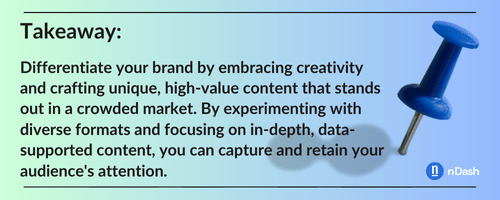
💡 Action items:
- Enhance storytelling techniques: Invest time in refining your storytelling skills. Focus on creating compelling narratives that evoke emotions and connect on a deeper level.
- Personalize content for your audience: Use audience segmentation to tailor your content to specific groups. Create personalized messages and experiences based on your audience’s unique preferences and behaviors.
- Collaborate with creative professionals: Partner with skilled content creators, such as writers, designers, and videographers, to elevate the quality of your content. Consider hiring freelancers or agencies with a proven track record of producing high-quality work.
Transparency and Authorship in Content
Misinformation runs rampant online, making trust the new gold standard for content. Transparency in authorship is key. When brands clearly show who creates their content, it builds accountability and authenticity.
Readers can see the author’s qualifications and potential biases, fostering a sense of connection. They can also follow trusted authors, deepening engagement. This transparency builds brand credibility and fosters long-term loyalty.
The Role of Authorship Transparency in Content Marketing
In today’s information age, where trust is hard-won, transparency in authorship is essential for building credibility with readers. By clearly attributing content to its creators, you not only personalize your brand but also signal the authenticity and expertise behind the information. This openness fosters trust and connection, leading to increased audience engagement and content sharing.
This practice not only personalizes your brand but also signals the authenticity and expertise behind the information. Here are some key reasons why authorship transparency is vital and how it can be effectively implemented:
Enhancing Credibility and Authenticity
Authorship boosts content credibility. Readers trust information with clear origins and traceable creators. By showcasing the qualifications, experience, and perspectives of your content creators, you can assure your audience that the information is well-researched and reliable. This transparency helps in building a reputation for honesty and integrity, which is crucial in gaining and maintaining audience trust.
Personalizing Your Brand’s Content Marketing Materials
Authorship transparency isn’t just about humanizing your content. It’s a strategic move to build trust and loyalty. Here’s how:
- Build trust: By showcasing the experts crafting your content, you establish credibility and make your brand more approachable. Readers appreciate knowing the qualifications and personalities behind the information they consume.
- Boost engagement: When readers connect with the authors, they feel a personal connection to your brand. This fosters deeper engagement, encouraging repeat visits and building a loyal following.
- Enhance user experience: Transparency personalizes the communication, making it feel more direct and genuine. This creates a positive user experience, keeping readers coming back for more.
Fostering Trust and Connection
Openly attributing content to its creators helps in fostering trust and connection with your audience. When readers see that real people with expertise and passion are behind the content, they are more likely to engage with it and share it within their networks. This trust is built on the understanding that the authors are accountable for their work and that the content is not anonymously produced. Trust is a critical factor in driving engagement and word-of-mouth promotion.
Considering Including Expert Contributions in Content Marketing Materials
By highlighting authorship, you can attract and encourage contributions from industry experts and thought leaders. Experts are more likely to collaborate with your brand if they receive recognition for their work. Featuring expert content not only enriches the quality of your information but also expands your brand’s reach and authority within the industry. This can lead to valuable partnerships and increased visibility.
Strategies for Implementing Authorship Transparency
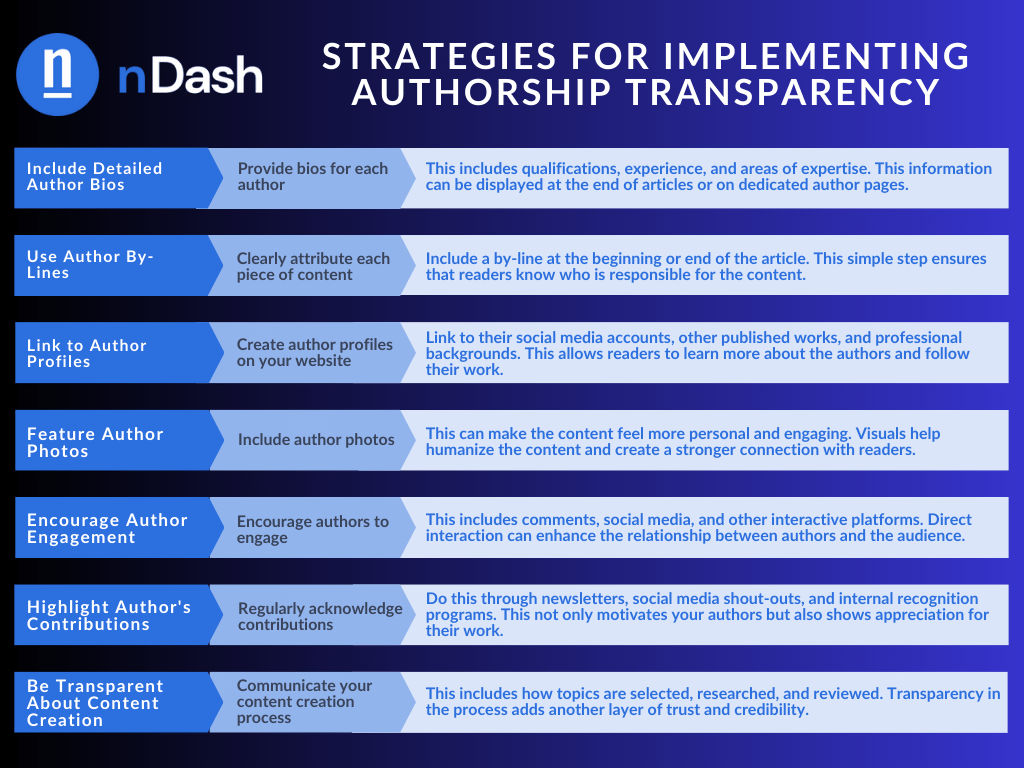
Examples of Brands Effectively Implementing Transparent Authorship Practices
Several brands are leading the way in transparent authorship. For instance, top publications like Forbes and Medium consistently include author bios detailing the writer’s background and expertise. This practice not only enhances credibility but also provides readers with context about the author’s qualifications and viewpoints. Additionally, brands like HubSpot regularly feature guest authors and industry experts, further boosting the content’s authority and trustworthiness.
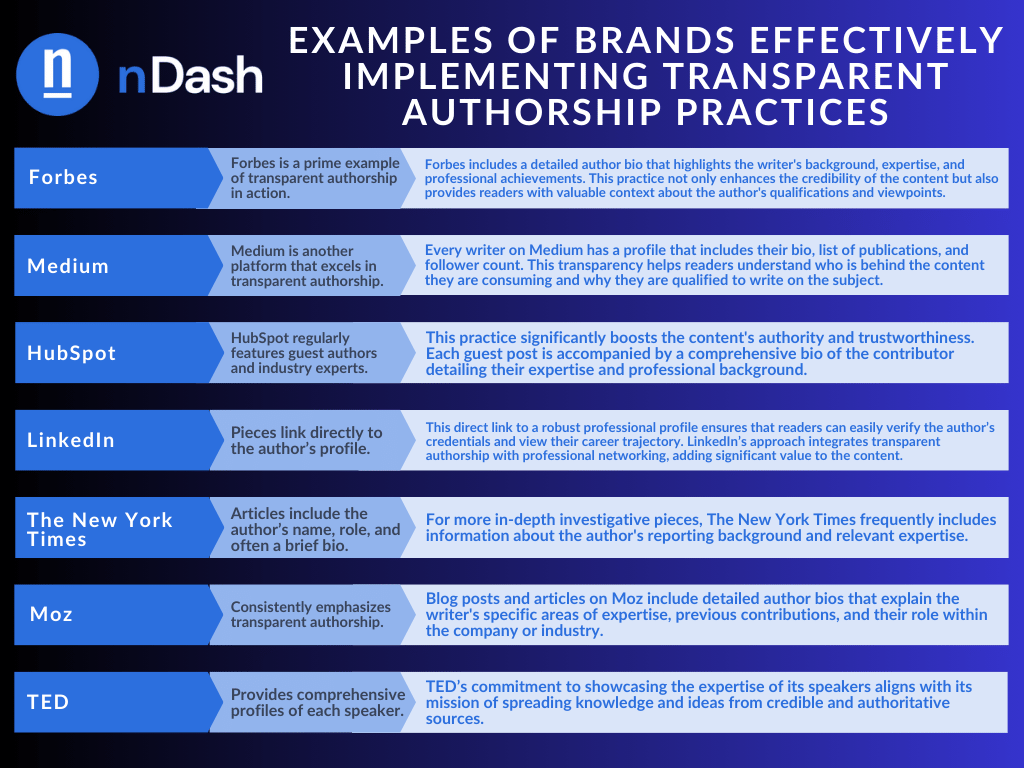
Benefits of Clear Author Attribution and Involvement in Content Marketing
Clear author attribution provides multiple benefits. It allows audiences to connect with the individuals behind the content, adding a personal touch that can enhance engagement. Moreover, it highlights the expertise and authority of the writers, reinforcing the content’s value. When used correctly, AI tools can help businesses attract 50% more organic traffic, emphasizing the importance of quality and transparency in content creation.
By openly identifying the individuals behind your content, you add a personal touch that can deepen audience engagement and build trust. Here are some key benefits of clear author attribution and involvement:
Enhancing Personal Connection
When audiences can see who is behind the content, it adds a personal touch that makes the material more relatable and engaging. Readers are more likely to connect with content that has a human face and voice, fostering a sense of familiarity and trust. This connection is essential for building long-term relationships with your audience, encouraging them to return to your content and engage more deeply.
Highlighting Expertise and Authority
Attributing content to specific authors highlights their expertise and authority, reinforcing the value and credibility of the information presented. Readers can assess the authors’ qualifications and experience, which adds weight to the content and enhances its trustworthiness. By showcasing the knowledge and skills of your writers, you position your brand as a credible and authoritative source in your industry.
Boosting Engagement and Interaction
Clear author attribution encourages more interaction between the audience and the content creators. Readers are more likely to leave comments, ask questions, and share content when they know who the author is. This engagement fosters a sense of community and dialogue, making your content more dynamic and interactive. Authors can also respond to comments and feedback, further strengthening the connection with the audience.
Enhancing Content Quality
Knowing that their work will be attributed to them motivates authors to produce higher-quality content. Clear author attribution fosters a sense of pride and ownership, encouraging writers to invest more effort into their work. This commitment to quality results in more thoroughly researched, well-written, and engaging content that benefits both the audience and the brand.
Building Trust and Transparency
Transparency in authorship builds trust with your audience. When readers see that content is created by identifiable individuals with verifiable expertise, they are more likely to trust the information presented. This trust is crucial in an era where misinformation is rampant, and audiences are increasingly skeptical of anonymous or poorly sourced content. Clear author attribution demonstrates your brand’s commitment to honesty and integrity.
Supporting Content Marketing and SEO Efforts
Clear author attribution can enhance your content marketing and SEO efforts. Search engines favor content that is associated with credible authors, which can improve your search rankings and visibility. Additionally, author profiles can accumulate authority over time, benefiting your overall SEO strategy. When used correctly, AI tools can help businesses attract 50% more organic traffic, emphasizing the importance of quality and transparency in content creation.
Monica Caraway, Content Lead at Orange Marketing, emphasizes the importance of finding highly skilled, qualified writers. “I’ve worked with many other content providers and found they all have highly variable degrees of writing talent. nDash is different. More than any other platform I’ve tried, nDash has a large stable of qualified writers with experience in a cross-section of industries.”
👉 Click here to learn more about search intent: Search Intent: Should You Optimize Your Blog for AI? – nDash.com
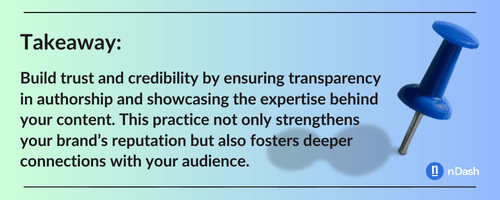
💡 Action items:
- Ensure clear author attribution: Every piece of content should include the author’s name and, if possible, a brief bio.
- Highlight expertise and background: To reinforce the credibility of your content, showcase the qualifications and experience of your content creators.
- Feature guest authors and experts: Regularly invite guest authors and subject matter experts to contribute, adding diverse perspectives and enhancing trust.
Leveraging Expert Insights in Content Marketing Efforts
High-quality content demands expertise. Brands are turning to experts to boost credibility, value, and trust. Experts bring deep knowledge and unique perspectives, tackling complex topics with authority and educating audiences. This elevates content, sets brands apart, and positions them as thought leaders, fostering deeper connections and a stronger overall content strategy.
The Growing Importance of Subject Matter Expert (SME) Contributions
AI-generated content is succeeding at one thing for sure – generic content. Search results show many brands churning out what looks like the same content. That’s where content marketing managers can take cues to stand out with SME contributions.
Their deep industry knowledge and authority lend credibility and trust to content, resonating strongly with audiences. SME insights not only elevate content quality but also offer unique perspectives that set brands apart from the competition.
SMEs possess extensive knowledge and experience in their specific fields, allowing them to provide detailed and accurate information that general content creators might miss. This depth of understanding ensures that the content is not only factually correct but also nuanced and insightful.
Moreover, the involvement of SMEs can enhance the engagement and loyalty of your audience. Readers are more likely to return to a source they trust for its expertise and reliability. Regularly featuring content by SMEs allows brands to solidify their position as industry leaders and become the preferred source for valuable information.
The unique perspectives offered by SMEs can also lead to innovative and thought-provoking content that stands out in a crowded marketplace. Their ability to foresee industry trends, identify emerging issues, and offer expert solutions can make the content more relevant and forward-thinking. This proactive approach not only meets the current needs of the audience but also prepares them for future developments.
Additionally, leveraging SME contributions can bolster your content’s SEO performance. Search engines prioritize high-quality, authoritative content. By integrating the specialized knowledge of SMEs, your content is more likely to be recognized as valuable and rank higher in search results, thereby increasing visibility and reach.
👉 Click here for more information about brand authenticity: Innovation vs. Integrity: The Impact of AI on Brand Authenticity and Consumer Trust – nDash.com
AI Tools That Enhance the Production and Distribution of Expert-Driven Content
With the advent of AI tools, producing and distributing expert-driven content has become more efficient and effective. These tools can help in various ways, from identifying trending topics and relevant experts to analyzing and repurposing content across different formats.
For instance, AI can transcribe expert interviews, summarize key points, and suggest the best distribution channels. Nearly 70% of marketers who did not use video in 2023 plan to do so in 2024. Why should content marketing managers know this? It shows the growing importance of multimedia content, which expert contributions can significantly enhance.
Chris DuBois is the head of operations and a growth marketer at Lean Labs. He notes, “Creating quality content shows you understand your customers’ needs and you’re listening to them. It’s pivotal in customer-centric marketing and something every company should strive for.”
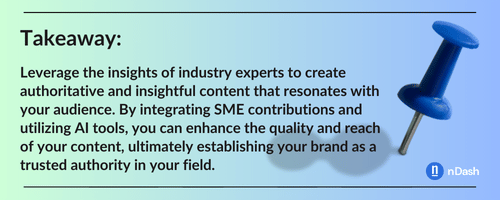
💡 Action items:
- Identify and collaborate with industry experts: When creating content, seek out and engage with experts in your industry. Their insights add significant value to your content.
- Use AI tools for content analysis and repurposing: Use AI to analyze expert content, extract key insights, and repurpose them across various formats, such as blogs, videos, and social media posts.
- Create a content library featuring expert insights: Develop a centralized repository of expert interviews and insights to inform and enrich future content creation.
Integrating PR and Content Strategies
Today, PR and content marketing work hand-in-hand to craft a powerful brand story. This marriage combines PR’s trust-building muscle with content marketing’s storytelling magic. A unified message across all channels? Check. Increased visibility and influence? Double-check. This teamwork also means smarter resource allocation, fostering collaboration between PR and marketing to create content that informs, engages, and drives results.
The Convergence of PR Tactics with Content Marketing
The lines between public relations (PR) and content marketing are increasingly blurring as brands recognize the power of a unified approach. Integrating PR tactics with content marketing efforts can amplify reach, enhance credibility, and drive more meaningful engagement with target audiences. By combining these strategies, brands can create a cohesive narrative that not only promotes their products or services but also builds lasting relationships with their audience.
Amplifying Reach
Instead of siloed efforts, consider PR and content marketing as a tag team for amplifying reach. PR tactics like press releases, media pitches, and influencer partnerships act as a springboard, propelling your content to a wider audience.
Established media connections and influencer networks become distribution channels, extending your content’s reach far beyond your immediate followers. This surge in exposure translates to attracting new followers, increasing website traffic, and generating excitement around your brand’s offerings.
Enhancing Credibility
Combining PR with content marketing can significantly enhance a brand’s credibility. PR efforts that include securing media coverage and third-party endorsements lend authority to content. When content is featured in reputable publications or endorsed by industry influencers, it gains an additional layer of trust and validation. This credibility is crucial in building a positive brand image and convincing potential customers of the brand’s reliability and expertise.
Driving Meaningful Engagement
Integrating PR tactics with content marketing helps drive more meaningful engagement with target audiences. PR strategies, such as storytelling and thought leadership, can be incorporated into content marketing to create more compelling and relatable narratives.
Brands that tell stories that resonate with their audience and address relevant industry issues can foster deeper connections, encouraging active participation. This two-way engagement is not only beneficial for building relationships but also for gaining valuable insights and feedback that can inform future strategies.
Creating a Cohesive Narrative
A unified approach to PR and content marketing allows brands to create a cohesive narrative that reinforces their messaging across different channels. Consistency in tone, style, and messaging ensures that the brand’s story is communicated effectively and memorably.
By aligning PR and content marketing efforts, brands can present a harmonized message that strengthens their identity. This cohesive narrative helps build a strong brand presence and make a lasting impression.
Leveraging Data-Driven Insights
Integrating PR with content marketing enables brands to leverage data-driven insights to optimize their strategies. By analyzing metrics from both PR campaigns and content marketing efforts, brands can gain a comprehensive understanding of what their audience expects.
This data can inform future content creation, media outreach, and engagement tactics, ensuring that efforts are targeted and effective. Data-driven insights also help measure the impact of integrated strategies and make informed decisions to improve performance.
PR Tactics in Content Distribution
Incorporating PR tactics into content distribution can enhance the visibility and impact of content marketing efforts. Techniques such as pitching content to journalists, collaborating with influencers, and distributing press releases can ensure that content reaches a wider audience. Additionally, using PR channels for content promotion can increase the chances of content being picked up by media outlets, further amplifying its reach and credibility.
Building Long-Term Relationships
A powerful duo for building long-term relationships with your audience is the strategic combination of PR and content marketing. Here’s why:
- Content as currency: Consistently delivering engaging, relevant, and high-value content establishes your brand as a trusted authority. This valuable content becomes your currency, attracting and retaining your audience.
- Community growth: Effective PR goes beyond press releases. It focuses on fostering a community around your brand through targeted outreach and audience engagement. This approach cultivates a loyal and vocal following.
- The loyalty loop: The synergy between PR and content marketing creates a powerful loop. Valuable content continuously attracts an audience, while PR efforts continuously build a community around it. This loyal community becomes your brand advocate, further strengthening your reputation and driving growth.
Practical Strategies for Integration
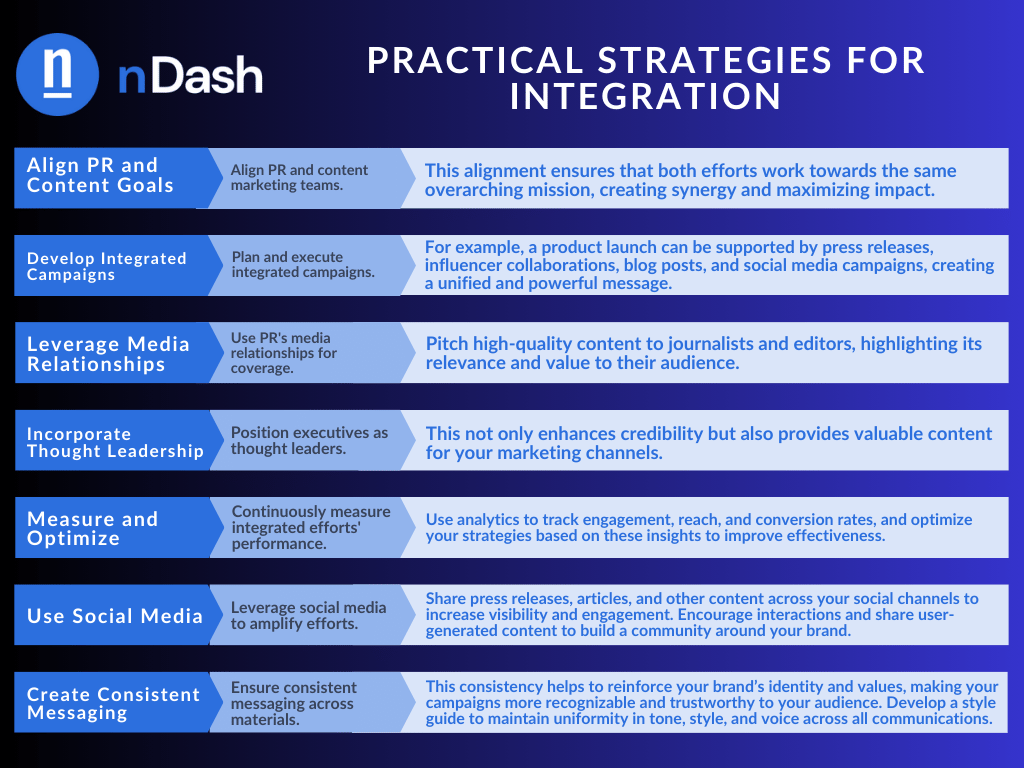
Using AI in Content Marketing to Enhance Outreach and Audience Engagement
AI technology is changing how brands conduct outreach and engage with their audience. With 77% of marketers agreeing that generative AI helps them create content more efficiently, it’s clear that AI can play an important role in streamlining and enhancing content strategies.
Identifying Key Influencers and Media Outlets
Forget spray-and-pray outreach.
AI can pinpoint the perfect influencers and media outlets for your brand. AI-powered tools analyze tons of data to identify key players who align with your target audience. These tools evaluate influencers’ reach, engagement rates, and industry relevance. This ensures your outreach efforts are laser-focused on individuals and platforms that can significantly amplify your message.
AI puts valuable time and resources back into content marketing managers’ hands by streamlining manual research processes. Doing so allows them to focus on creating high-quality content that resonates with their audience. Build strategic partnerships with these identified influencers and media outlets to drive meaningful engagement and increase brand visibility.
Personalizing Outreach Efforts
Personalization is critical for effective outreach, and AI excels in this area by analyzing audience data to craft personalized messages. AI can segment audiences based on various criteria, such as behavior, preferences, and past interactions, allowing you to tailor your outreach efforts accordingly.
When you personalize your marketing efforts, such as emails, social media ads, and content recommendations, your audience feels valued and understood. This fosters stronger connections and leads to higher engagement rates.
Analyzing Audience Engagement
AI tools go beyond basic metrics, uncovering hidden patterns in audience behavior through click-through rates, time spent on pages, social media interactions, and conversion rates. This actionable knowledge empowers you to create content your audience craves, leading to higher engagement. With continuous analysis and optimization by AI, your content remains relevant and effective, ensuring you never miss the mark.
Optimizing Content Distribution
Imagine publishing content exactly when your audience craves it. AI takes the guesswork out of distribution. By analyzing historical data, AI pinpoints the optimal times to publish and share your content across the most effective channels. Powerful AI automation tools streamline the distribution process, freeing up your team to focus on what they do best: creating stellar content.
Enhancing Content Creation
Generative AI tools can assist in content creation by providing ideas, drafting initial copies, and suggesting improvements. These tools can analyze existing content, audience feedback, and trending topics to generate content that is likely to perform well. While AI can handle repetitive and data-driven writing tasks, human writers can focus on adding creativity, personality, and emotional resonance to the content, resulting in a well-rounded and engaging output.
Creating Distinctive and Valuable Content
Jessica N. Abraham explains, “While AI can be beneficial in certain areas, like energy grid management or generating headline ideas, it falls short when it comes to writing and editing. AI-generated content often lacks the finesse of human writing and can contain errors or miss important nuances. It’s important for a marketer or agency to have human editors involved to ensure the quality and accuracy of the content.”
AI can assist in this endeavor by identifying content gaps and opportunities, suggesting unique angles, and ensuring that the content is optimized for search engines and audience preferences.
👉 Click here about leveraging AI for ideation: nDash Launches AI Content Ideas
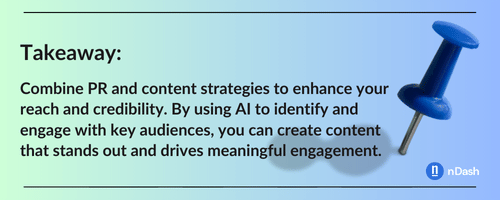
💡 Action items:
- Evaluate and update your content calendar: Review your current content calendar and integrate PR-driven content themes and campaigns. Plan content that aligns with upcoming PR events, announcements, or initiatives.
- Train your team on integrated strategies: Conduct training sessions for your PR and content marketing teams to familiarize them with integrated strategies and the use of AI tools for outreach and engagement.
- Measure and analyze integrated campaign performance: Set up a system to track key metrics and KPIs for your PR and content marketing efforts. Dive deep into analytics to track engagement (likes, comments, shares), reach (impressions), and conversions (leads, sales). This data empowers you to optimize your campaigns for maximum impact.
Embracing the Future of Content Marketing
The future of content marketing hinges on quality, authenticity, and creativity. While AI integration presents challenges, it also unlocks exciting possibilities. It compels brands to revamp strategies and embrace innovation, paving the way for a promising future in content marketing.
Key trends point towards quality over quantity, humanized brand voices, diverse content formats, and leveraging expert insights. By embracing AI and maintaining transparency in content creation, brands can build trust and forge deeper connections with their audience in a crowded digital space. The future belongs to content marketing managers who can combine human creativity with AI efficiency to deliver value and personalization.
